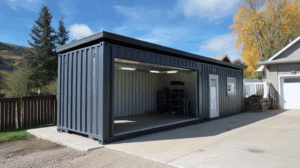Thinking Outside the Box: How to Convert a Shipping Container into a Practical Garage
When it comes to creating additional space for your belongings, thinking outside the box can lead you to some truly innovative solutions. One such solution is converting a shipping container into a practical garage. These sturdy and versatile containers, originally designed for transporting goods across the globe, can be transformed into functional and secure spaces for cars, tools, and equipment. In this blog post, we will explore the steps involved in converting a shipping container into a practical garage.
Step 1: Choosing the Right Container
The first step in this conversion process is finding the right shipping container. Ideally, you should look for a container that is in good condition, free from major structural damage, and has minimal rust or corrosion. It’s important to consider the size of the container as well, ensuring it is large enough to accommodate your vehicle and any additional storage needs. Common container sizes include 20 feet and 40 feet in length, with a standard height and width.
Step 2: Preparing the Container
Before you can begin converting the shipping container into a garage, some preparations are necessary. Start by thoroughly cleaning the container, removing any dirt, debris, or residual substances from its previous use. Next, inspect the container for any signs of rust or corrosion. If present, treat these areas with a rust converter or primer to prevent further deterioration. It’s also important to seal any gaps or holes in the container to ensure it remains weatherproof.
Step 3: Installing Doors and Windows
To make the container more accessible and functional as a garage, you will need to install doors and windows. The type and number of doors will depend on your specific needs, but popular options include roll-up doors or sliding doors. Windows can be added for natural light and ventilation. Consider the placement of these openings to maximize convenience and security.
Step 4: Insulating the Container
To create a comfortable environment within the garage, insulation is essential. Insulating the container will help regulate the temperature and reduce moisture buildup. There are various insulation options available, such as spray foam insulation, rigid foam boards, or fiberglass insulation. Choose the option that best suits your needs and climate conditions.
Step 5: Electrical and Lighting
To fully utilize the garage space, you will need to install electrical outlets and lighting fixtures. This will allow you to power tools, charge batteries, and create a well-lit workspace. Hiring a professional electrician is highly recommended to ensure the safe installation of wiring and electrical components.
Step 6: Flooring and Storage Solutions
The final step in converting a shipping container into a practical garage is the installation of flooring and storage solutions. For the floor, consider options like epoxy coating or rubber mats for durability and ease of cleaning. To maximize storage space, you can add shelves, cabinets, or wall-mounted tool organizers. Customizing the interior layout to suit your specific needs will ensure efficient use of the available space.
Conclusion
Converting a shipping container into a practical garage is a unique and cost-effective way to create additional storage and workspace. By following these steps, you can transform a simple container into a functional and secure garage for your vehicles, tools, and equipment. Remember to carefully plan each aspect of the conversion process and consult professionals when needed. With a little creativity and some outside-the-box thinking, you can turn an ordinary shipping container into a practical and versatile garage space.
Garage Goals: Unleashing the Potential of a Shipping Container Conversion
When it comes to creative and innovative ways to repurpose shipping containers, the possibilities are endless. From trendy pop-up shops and cozy homes to unique office spaces, these versatile structures have proven their worth time and time again. But have you ever considered using a shipping container as a garage?
A shipping container conversion can offer a multitude of benefits when it comes to storing your vehicles, tools, and equipment. Not only are they durable and secure, but they also provide a cost-effective and sustainable alternative to traditional garages. In this blog post, we’ll explore the potential of a shipping container conversion and how it can be your ultimate garage goals.
Durability and Security
One of the primary advantages of using a shipping container as a garage is its inherent durability. Constructed to withstand the harsh conditions of long-distance shipping, these steel structures are designed to last. They are built to resist extreme weather conditions, making them suitable for any climate.
When it comes to security, shipping containers are a fortress for your prized possessions. With their solid steel construction and lockable doors, you can have peace of mind knowing that your vehicles and equipment are safe from theft and vandalism. Additionally, shipping container conversions can be customized with added security features such as reinforced doors, alarms, and even surveillance systems.
Versatility and Customization
Unlike traditional garages, shipping container conversions offer unparalleled versatility and customization options. With a little bit of creativity and planning, you can transform a simple metal box into your dream garage. Whether you need extra storage space, a workshop, or a place to showcase your classic car collection, a shipping container conversion can be easily tailored to your specific needs.
From insulation and ventilation to lighting and electrical outlets, the possibilities for customization are endless. You can add windows for natural light, install shelving units for efficient organization, and even incorporate a hydraulic lift for your car maintenance needs. The beauty of a shipping container conversion lies in its ability to be transformed into a functional and personalized space that reflects your unique style and requirements.
Cost-Effectiveness and Sustainability
When compared to traditional brick-and-mortar garages, shipping container conversions offer a more cost-effective solution. The initial investment and construction costs are significantly lower, making it an attractive option for those on a budget. Additionally, shipping containers are readily available and can be easily transported to your desired location, saving you time and money on building materials and labor.
In an era where sustainability is increasingly important, repurposing shipping containers as garages is a great way to reduce waste and minimize your carbon footprint. By giving these steel giants a second life, you are contributing to the recycling and upcycling movement. Furthermore, shipping container conversions can be designed to be energy-efficient, with the incorporation of solar panels, rainwater harvesting systems, and other eco-friendly features.
Conclusion
A shipping container conversion as a garage is more than just a practical solution; it’s a statement of creativity, sustainability, and individuality. With their durability, security, versatility, and customization options, these repurposed steel structures offer endless possibilities for creating the ultimate garage space. Whether you’re a car enthusiast, a DIYer, or simply in need of extra storage, a shipping container conversion can unleash the potential of your garage goals. So why settle for a traditional garage when you can think outside the box? Explore the world of shipping container conversions and transform your garage dreams into reality!
Container to Carport: The Ultimate Guide to Creating a Garage from a Shipping Container
Are you in need of a garage space but don’t want to go through the hassle and expense of building a traditional structure? Look no further than a shipping container! With a little creativity and some DIY skills, you can transform a simple shipping container into a functional and stylish carport. In this ultimate guide, we will walk you through the steps to create your very own garage from a shipping container.
Step 1: Choosing the Right Container
The first step in this project is to find the perfect shipping container. Look for a container that is in good condition, with minimal rust and structural damage. It’s important to consider the size of your vehicles and the space you have available when selecting a container. Standard shipping containers are typically 8 feet wide, 8.5 feet tall, and come in lengths of 20 or 40 feet. Choose a size that suits your needs.
Step 2: Preparing the Site
Before placing the container, you need to prepare the site. Clear the area and ensure the ground is level. It’s also a good idea to lay a concrete foundation to provide a stable base for the container. This will help prevent any shifting or sinking over time.
Step 3: Modifications
Once you have your container in place, it’s time to make the necessary modifications to turn it into a carport. Start by removing the side walls and part of the roof to create an open structure. This can be done using a saw or plasma cutter. Remember to wear protective gear and exercise caution when working with power tools.
Next, reinforce the remaining structure to ensure it can withstand the weight of your vehicles and any harsh weather conditions. Consider adding additional support beams and cross bracing as needed. It’s also a good idea to seal any gaps or openings to prevent water from entering the container.
Step 4: Roofing
To protect your vehicles from the elements, you will need to install a roof on your container carport. There are several options to choose from, including a traditional pitched roof or a flat roof with a waterproof membrane. Consider the climate in your area and the aesthetic you want to achieve when selecting the roofing material.
Step 5: Ventilation and Lighting
Proper ventilation is essential in any garage space. Install windows or vents to allow for air circulation and prevent condensation buildup. Additionally, consider adding lighting fixtures to ensure visibility during the day and night. LED lights are a popular choice due to their energy efficiency and longevity.
Step 6: Finishing Touches
Now that the structure is complete, it’s time to add the finishing touches. Paint the exterior of the container in a color that complements your home or surroundings. You can also add siding or cladding to further enhance the appearance. Consider installing a garage door or a gate to secure your vehicles and belongings.
Benefits of a Shipping Container Carport
Creating a garage from a shipping container offers several advantages. Firstly, it is a cost-effective solution compared to traditional construction. Shipping containers are readily available and can be purchased at a fraction of the cost of building a new garage. Additionally, they are durable and weather-resistant, providing a secure space for your vehicles.
Shipping container carports are also highly customizable. You have the freedom to design and modify the structure to meet your specific needs. Whether you want to add windows, insulation, or shelving, the possibilities are endless.
Conclusion
Turning a shipping container into a carport is a practical and innovative way to create a garage space. By following the steps outlined in this ultimate guide, you can transform a simple container into a functional and stylish shelter for your vehicles. Whether you’re looking for a cost-effective solution or a unique design statement, a shipping container carport is an excellent choice. So, get ready to roll up your sleeves and start building your very own garage from a shipping container!
Revamping Your Ride’s Home: Transforming a Shipping Container into a Stylish Garage
If you’re a car enthusiast or someone who simply wants a unique and functional space for your vehicle, why settle for a traditional garage? Shipping containers have become increasingly popular for their versatility and affordability, making them an excellent choice for revamping your ride’s home. With a little creativity and a touch of DIY spirit, you can transform a shipping container into a stylish garage that not only protects your car but also adds a touch of modern sophistication to your property.
Why Choose a Shipping Container?
Shipping containers, also known as cargo containers, are designed to withstand harsh weather conditions and rough handling during transportation. Made from durable steel, these containers are built to last. By repurposing a shipping container as your garage, you’re not only making an eco-friendly choice but also utilizing a sturdy and secure structure for your prized possession.
Planning and Preparation
Before diving into the transformation process, it’s important to have a well-thought-out plan. Consider the size of your vehicle and how much additional space you may need for storage, maintenance, or even a small workshop. Assess the available area on your property and ensure that it can accommodate the container while still allowing enough room for maneuvering your vehicle.
Insulation and Climate Control
One of the primary concerns when converting a shipping container into a garage is insulation. Shipping containers are designed to transport goods, not to provide comfortable living or working spaces. To ensure your garage maintains a suitable climate for your vehicle, it’s crucial to insulate the container properly.
There are various insulation options available, such as spray foam, rigid foam boards, or even recycled denim insulation. Consider consulting with a professional to determine the best insulation method for your specific needs. Additionally, installing climate control systems like air conditioning or heating units will help regulate the temperature and keep your car in optimal condition throughout the year.
Lighting and Ventilation
Ample lighting and proper ventilation are essential for any functional garage space. When it comes to lighting, consider installing LED lights for energy efficiency and bright illumination. Depending on the container’s structure, you can either mount lights on the ceiling or incorporate wall-mounted fixtures to optimize the space.
For ventilation, windows or vents can be added to allow fresh air circulation and prevent any potential buildup of moisture or odors. Mechanical exhaust fans can also be installed to improve air quality and keep the space well-ventilated.
Security Measures
Protecting your vehicle from theft or vandalism should be a top priority when designing your stylish garage. Fortunately, shipping containers are structurally robust, making them inherently secure. However, adding additional security measures can provide extra peace of mind.
Consider installing a sturdy locking mechanism on the container doors and reinforcing the windows with security bars or shatterproof film. You can also integrate a security system with motion sensors, cameras, and even remote monitoring capabilities to ensure your vehicle is safe at all times.
Aesthetics and Finishing Touches
Now comes the fun part – transforming your shipping container into a visually appealing garage that complements your personal style. The exterior can be painted in a color of your choice, or you can opt for a bold, eye-catching design to make a statement. Adding a pergola or awning above the container’s entrance can provide shade and enhance the overall aesthetic appeal.
On the interior, consider installing shelving units or cabinets for storage, a workbench for small repairs or modifications, and even a sound system to create a pleasant ambiance while working on your vehicle. Don’t forget to add some personal touches, such as posters, vintage signs, or artwork that reflect your automotive passion.
Conclusion
Revamping your ride’s home by transforming a shipping container into a stylish garage is a creative and cost-effective way to provide your vehicle with a unique shelter. With careful planning, insulation, proper lighting, ventilation, security measures, and a dash of personal style, you can create a garage that not only protects your car but also becomes an extension of your passion for automobiles. So, unleash your inner DIY enthusiast and embark on this exciting journey to give your car a home it truly deserves.
From Cargo to Car Haven: Turning a Shipping Container into the Ultimate Garage
Introduction
When it comes to creativity and repurposing, few things can beat the versatility of a shipping container. Originally designed to transport goods across the oceans, these steel behemoths have found new life in various industries, from housing to pop-up stores. But one of the most intriguing transformations is turning a shipping container into the ultimate garage. In this blog post, we’ll explore the benefits, design considerations, and the steps involved in creating your very own car haven.
Benefits of a Shipping Container Garage
-
Affordability: Compared to traditional garages, shipping container conversions offer a cost-effective alternative. The containers themselves are relatively inexpensive, and the conversion process can be done with a modest budget.
-
Durability: Built to withstand the harsh conditions of sea travel, shipping containers are designed to be extremely durable. They can withstand extreme weather conditions and provide excellent protection for your vehicles.
-
Mobility: Unlike permanent garages, shipping container garages are portable and can be easily transported to a new location if needed. This flexibility makes them ideal for those who frequently move or want to have a temporary garage solution.
-
Security: Made of steel, shipping containers are inherently secure structures. With the addition of reinforced doors and windows, you can rest assured that your prized vehicles will be safe from theft or vandalism.
-
Customizability: Shipping containers offer a blank canvas for customization. You have the freedom to design and modify the interior and exterior to suit your specific needs and preferences. From insulation to lighting, the possibilities are endless.
Design Considerations
Before diving into the conversion process, it’s crucial to consider a few design factors to ensure your shipping container garage meets your requirements:
-
Size: Choose a container size that can comfortably accommodate your vehicles and provide additional space for storage or a workshop area. Standard container sizes range from 20 to 40 feet in length, with a width of around 8 feet.
-
Ventilation and Insulation: Proper ventilation is necessary to prevent moisture buildup and protect your vehicles from damage. Insulation is essential for temperature regulation, especially if you live in an area with extreme weather conditions.
-
Lighting: Adequate lighting is crucial for visibility and working on your vehicles. Consider installing windows for natural light and LED lighting for energy efficiency.
-
Security Features: Enhance the security of your garage by installing sturdy locks, security cameras, and an alarm system. This will ensure that your vehicles are safe at all times.
-
Electrical and Plumbing: Depending on your needs, you may want to install electrical outlets, lighting fixtures, or even plumbing for a wash area. Plan these aspects in advance to avoid any complications during the conversion process.
Steps to Transform a Shipping Container into a Garage
-
Choose the Right Container: Find a shipping container that meets your size and quality requirements. Consider purchasing from a reputable supplier to ensure you get a structurally sound container.
-
Prepare the Site: Clear the area where you plan to place the container garage. Ensure the ground is level and stable, and obtain any necessary permits or permissions required by your local authorities.
-
Insulation and Ventilation: Apply insulation materials to the interior walls and ceiling of the container to regulate temperature. Install vents or fans to ensure proper airflow and prevent condensation.
-
Customize the Interior: Install lighting fixtures, electrical outlets, and any necessary plumbing. Consider adding storage shelves or cabinets to maximize the use of space.
-
Enhance Security: Install reinforced doors and windows, as well as security features such as cameras and alarms. Ensure that your garage is well-protected from potential threats.
-
Exterior Modifications: Customize the exterior of the container to match your personal style. This could involve adding a fresh coat of paint, cladding, or even creating a covered carport area.
-
Organize and Decorate: Once the major construction work is complete, organize the interior to optimize space for your vehicles and any additional equipment. Add personal touches and decorations to make the garage feel like a true haven for your cars.
Conclusion
Transforming a shipping container into the ultimate garage is an innovative and cost-effective solution for car enthusiasts and homeowners alike. With their durability, mobility, and customizability, these containers offer a unique opportunity to create a secure and personalized space for your vehicles. By carefully considering design factors and following the conversion process, you can turn a simple shipping container into a car haven that will undoubtedly impress both you and your friends.




